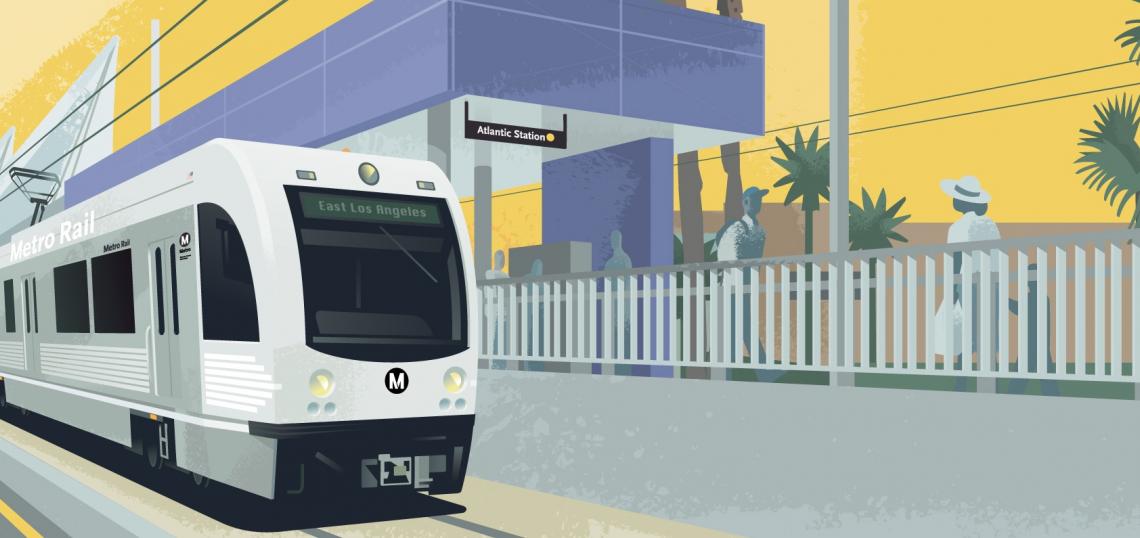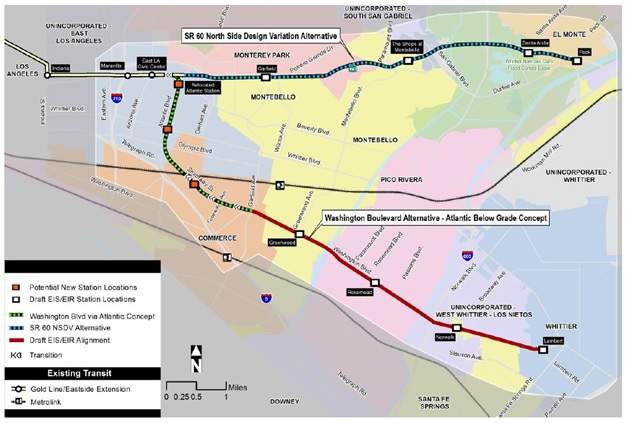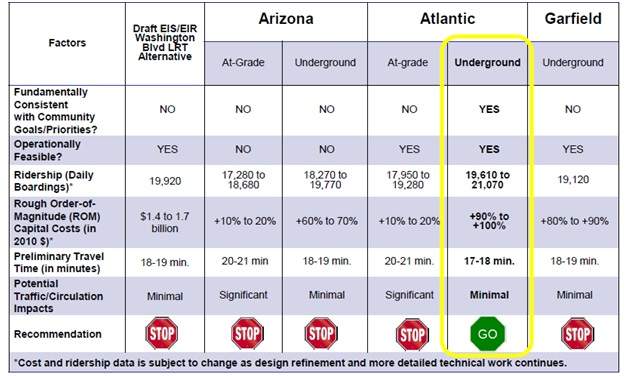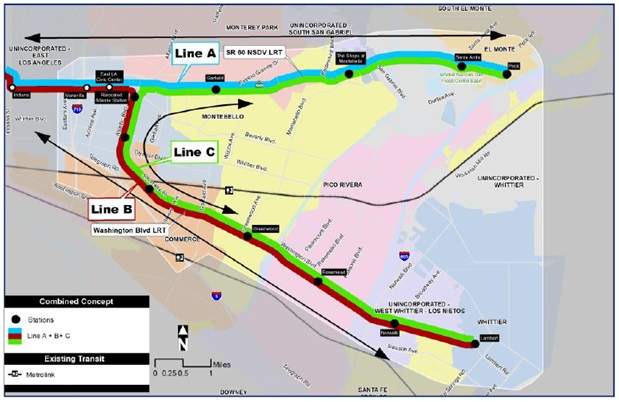Last month, Metro staff presented a series of updates on the eastside Gold Line Extension to the Board's Planning and Programming Committee. The presentation detailed route revisions for both the 60 freeway and the Washington Boulevard alternatives, along with a new combined alternative for analysis in the upcoming final round of environmental studies for the project. Notably, despite a number of financially-significant details that emerged, there was little discussion on the item, which will be heard by the full board at the end of May.
Staff have chosen a new route to connect the existing Gold Line terminus to Washington Boulevard, in order to allay the concerns of transit-inhospitable Montebello. New plans call for the Gold Line to hook south onto Atlantic Boulevard, operating below-grade as it passes through the complex freight environment of Commerce before meeting up with the previously defined Washington Alternative on the other side of the Citadel.
While the Atlantic option was the best of the various routes that Metro was considering, some of the details should have given Metro’s directors pause. According to staff, the below-grade section will double the original projected cost of the Washington alternative, meaning this one branch of the project might cost as much as $3.8 billion to construct at present-day dollar value. What’s worse, there is precious little transit value to this sudden cost spike. Metro projects that marginal ridership, compared to the previously-defined Washington alternative, will increase by 6% at most or actually decline by 2% in the worst-case scenario. The tunnel also doesn’t speed trips up very much, with the estimated trip time ranging from zero to two minutes faster than the previous Washington alternative.
Budgeted at $3.8 billion, this prong of the Gold Line Extension alone would cost a truly incredible $180,000 per projected rider. Compare that to the Regional Connector, where a recent request to increase the life-of-project budget by $200 million gave Metro directors “heartburn”, and the muted response to the ballooning Gold Line costs is eyebrow-raising. After all, the Regional Connector, inclusive of multiple budget overruns, is still expected to have roughly five times the number of riders as the Gold Line extension.
Even setting aside new proposals for additional stations at the Citadel and a Monterey Park commercial development, the cost of the project is bound to increase further as Metro continues to develop the combined alternative. This newly defined alternative will require the construction of an underground three-way junction at Pomona and Atlantic, as well as the purchase of additional rail vehicles to operate what is sure to be a lightly-used C-shaped service from South El Monte to Whittier. This arrangement is the outgrowth of an inversion of transit priorities. The Board determined independently that both the SR-60 and Washington Boulevard routes could be built during the life of the Measure M sales tax, and directed staff to make it work after the fact. Operating as branches of the Gold Line, which itself branches off the downtown Regional Connector, this would limit both alternatives to dismal 10-minute frequencies during peak hours.
Metro has attempted to circumvent this outcome by creating the so-called Line C operating from one branch to the other. While nominally this would allow for 5 minute headways on the respective branches, in actuality it won’t do so in a way that most riders will benefit from. The primary benefit of the line is not travel within the corridor, but connectivity to the wider rail network, particularly access to the job-rich west. The combined alternative, however, will not actually make it much faster for riders to downtown and beyond.
Let’s look at how that plays out.
If Line C to Whittier arrives at Peck, the expected wait time for Line A to Santa Monica would be 5 minutes. The passenger gets on Line C instead and travels to Atlantic station for a transfer to Line B to Santa Monica, where the expected wait time is again 5 minutes. For travelers on line B, it’s even worse. Metro proposes to rebuild the current Atlantic station underground south of the wye junction. In order to transfer to Line A, passengers must backtrack to Garfield first, and then wait. It seems likely that either walking from Atlantic west to Mednik or simply waiting for Line B to arrive would be faster than taking Line C.
In concluding remarks on the new build alternative for study, staff indicated that Metro has $6 billion in Measure M funds for this project, and that “preliminarily, it could be enough to build both lines.” More than anything, this appears to be indicative of Metro’s mindset as it embarks on the final environmental study for the second phase of the Gold Line. Directors have already prejudged what the end product should look like, and staff have been given the unenviable task of jamming it all together until it fits. The money is there to play around with, and given the circumstances, no officials seem inclined to come out and say that this project’s flaws are increasingly overwhelming its benefits. There is an inclination among local electeds to regard any rail line as better than no rail line, and not to be too picky about the specifics. But treating the Gold Line as strictly a political giveaway is a mistake. This region of the county deserves better transit, and Metro has a huge amount of money for just that purpose. The six-billion-dollar question seems to be: Can this really be what a comprehensive rail network for the Eastside should look like?
Scott covers transportation and governance issues from his home in Silver Lake. Follow him on Twitter @safrazie.
- Metro Archive (Urbanize LA)
- Metro Staff Recommends Gold Line Extension Under Atlantic Boulevard (Urbanize LA)









